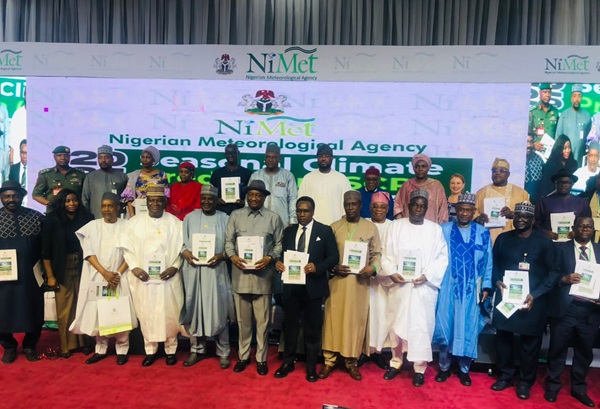
The Nigerian Meteorological Agency (NiMet) has predicted an early onset of rainfall across 13 states in the southern region while forecasting a delayed onset in eight states across the northern and central regions.
Minister of Aviation and Aerospace Development, Mr. Festus Keyamo (SAN) made this known during the unveiling of the 2025 Seasonal Climate Prediction (SCP) in Abuja. Themed “The Role of Early Warnings Towards a Climate-Resilient Aviation Industry for Sustainable Socio-Economic Development,” the event emphasised the importance of early warning systems in mitigating climate-related risks.
According to NiMet’s predictions, the length of the 2025 rainy season is expected to be mostly normal across the country. However, significant rainfall events will likely occur before the official onset of the season in some areas.
An early onset of rainfall is expected in Delta, Bayelsa, Rivers, Anambra and parts of Oyo, Ogun, Osun, Ondo, Lagos, Edo, Enugu, Imo and Ebonyi states. Meanwhile, the onset of rains is predicted to be delayed in Plateau, Kaduna, Niger, Benue, Nasarawa, Taraba, Adamawa and Kwara states. Other parts of the country are expected to experience a normal onset of the rainy season.
Additionally, NiMet forecasts an earlier-than-usual end to the rainy season in Zamfara, Katsina, Kano, Kaduna, Jigawa, Plateau, Bauchi, Borno, Yobe, Adamawa, Taraba, Niger, Kwara, Kogi, the Federal Capital Territory (FCT), Ekiti and Ondo states. Conversely, a delayed end of the season is projected in Kaduna, Nasarawa, Benue, Lagos, Kwara, Taraba, Oyo, Ogun, Cross River, Delta, Akwa Ibom, Ebonyi, Anambra and Enugu states.
The ‘Little Dry Season (LDS),’ commonly referred to as the “August Break,” is predicted to begin in late July. The break is expected to be severe in Lagos and Ogun states, lasting between 27 to 40 days. Moderate LDS effects are anticipated in parts of Ogun, Oyo and Ekiti states, while Osun, Oyo, Kwara and northern parts of Ondo are likely to experience mild LDS effects.
NiMet also predicts that both daytime and nighttime temperatures will be above the long-term average across the country. Warmer-than-normal temperatures are expected from January to March and in May 2025, while April is forecasted to be slightly cooler in some areas. However, most northern states will likely experience significantly higher-than-normal temperatures throughout the year.
Speaking at the event, Keyamo described the SCP document as a vital resource for informed decision-making. He emphasised that the predictions offer valuable insights into weather and climate patterns, helping various sectors prepare for potential challenges.
“This document equips key industries – including agriculture, disaster risk management, health, marine operations, and transport, particularly aviation – with the foresight needed to plan effectively, mitigate risks and seize emerging opportunities,” he stated.
Keyamo urged state governments and relevant stakeholders to collaborate with NiMet in disseminating the SCP across communities. He also emphasised the need for Nigerians to pay attention to climate forecasts, heed early warnings and take proactive steps to mitigate climate risks.
In his address, permanent secretary of the Ministry of Aviation and Aerospace Development, Dr. Ibrahim Kana reaffirmed the critical role of NiMet’s SCP in providing accurate climate predictions for various sectors.
According to him, the SCP is not just a prediction tool but an essential early warning mechanism that helps individuals, businesses, and governments make informed climate-related decisions.
“This year’s SCP unveiling features several notable enhancements, including the launch of a summary SCP document tailored for policymakers and translations into Hausa, Igbo, Yoruba and Pidgin to improve accessibility,” he explained.
Kana also highlighted the presentation of a comprehensive report on Nigeria’s climate trends for 2024, reinforcing the government’s commitment to ensuring climate information reaches even the most remote communities.
“This event underscores our dedication to public engagement and knowledge dissemination across all 36 states and the FCT,” he added.
Director-general of NiMet, Prof. Charles Anosike emphasised the importance of feedback from stakeholders in refining the SCP document.
He explained that early warning initiatives require collaboration at all levels of governance, adding that the SCP serves as an early warning tool for all Nigerians.
“The success of this initiative depends on how well actors in various sectors adopt the information, integrate it into their planning, and provide constructive feedback to improve future forecasts,” Anosike stated.
He acknowledged the support of the Minister of Aviation, the chairman of the Senate Committee on Aviation, the Chairman of the House Committee on Aviation Technology and other key stakeholders in advancing NiMet’s mandate.
“Our collective efforts are crucial in strengthening Nigeria’s climate resilience and ensuring that accurate climate predictions translate into meaningful action,” he concluded.
With the 2025 SCP projections now available, governments, businesses and communities must act swiftly to integrate these forecasts into their planning and risk mitigation strategies. As Nigeria continues to grapple with climate change impacts, leveraging accurate and timely weather predictions will be essential in building climate resilience and safeguarding livelihoods.
NiMet urges all stakeholders to remain proactive, adhere to climate advisories and collaborate in ensuring that early warning systems translate into practical solutions for sustainable development.

